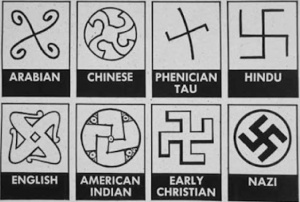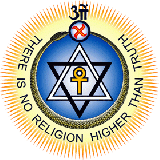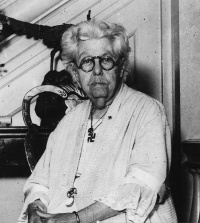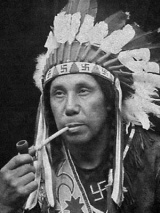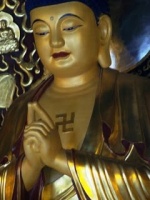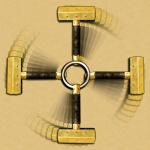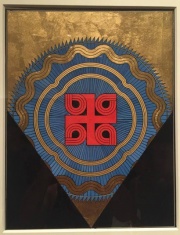Swastika
The Swastika is an equilateral cross with its arms bent at right angles, in either right-facing (卐) form or its mirrored left-facing (卍) form.
The Sanskrit word svastika (स्वस्तिक), meaning any lucky or auspicious object, and in particular a mark made on persons and things to denote auspiciousness. It is composed of su- meaning "good, well" and asti "to be". Suasti thus means "well-being." The suffix -ka either forms a diminutive or intensifies the verbal meaning, and suastika might thus be translated literally as "that which is associated with well-being," corresponding to "lucky charm" or "thing that is auspicious."
It is considered to be a very sacred and auspicious symbol in Hinduism, Buddhism and Jainism, and it was regarded the same in the Nordic tradition.
General information
According to H. P. Blavatsky, "there was a time, when the Eastern symbol of the Cross and Circle, the Swastica, was universally adopted".[1] She added:
Throw a retrospective glance, and see it used alike by the Initiates and Seers, as by the priests of Troy (found by Schliemann on the site of that old city). One finds it with the old Peruvians, the Assyrians, Chaldeans, as well as on the walls of the old-world cyclopean buildings; in the catacombs of the New world, and in those of the Old (?), at Rome, where, because the first Christians are supposed to have concealed themselves and their religion, it is called Crux Dissimulata.[2]
Earliest archaeological evidence of swastika-shaped ornaments dates back to the Indus Valley Civilization of Ancient India as well as Classical Antiquity. Swastikas have also been used in other various ancient civilizations around the world. It remains widely used in Indian religions, specifically in Hinduism, Buddhism and Jainism, primarily as a tantric symbol to evoke 'shakti' or the sacred symbol of auspiciousness. The swastika is also a Chinese character used in East Asia representing eternity and Buddhism. In medieval Europe it was used by Christians and called a gammadion (because it is made of four Greek gamma letters) or in England a fylfot because it was used as a design to fill (fyl) the foot (fot) of stained glass windows. It was also found among natives in the Americas.
The Nazis adopted this ancient holy symbol (which they called Hakenkreuz or “bent cross”) and perverted its meaning, much as the Ku Klux Klan in the United States adopted the cross and perverted its meaning as a sign of hate and intimidation. But the swastika is still used as a holy symbol all over the world, for example by the Jains of India, whose religion is devoted to harmlessness.
All crosses symbolize some aspect of manifestation. The swastika is a whirling cross, its clockwise (righthanded, sunwise, or deasil) motion suggesting the dynamic forces of creation. So the swastika represents the great process of becoming, which produces the world in which we live. It symbolizes what astrophysicists call the expansion of the universe. When the swastika is represented as turning in the opposite direction (that of the Nazi Hakenkreuz), it symbolizes the forces of contraction or destruction that bring about the end of a world when it has completed its evolution. The reverse turning swastika is not evil, but merely a symbol of the winding up of creative energies and of the process of coming to an end.
Mme. Blavatsky wrote in the 1880's:
The Svastica is found heading the religious symbols of every old nation. It is the “Worker’s Hammer” in the Chaldean Book of Numbers, the “Hammer” just referred to in the “Book of Concealed Mystery” (Ch. I., §§ 1, 2, 3, 4, etc.), “which striketh sparks from the flint” (Space), those sparks becoming worlds. It is “Thor’s Hammer,” the magic weapon forged by the dwarfs against the Giants, or the pre-cosmic Titanic forces of Nature, which rebel and, while alive in the region of matter, will not be subdued by the Gods, the Agents of Universal Harmony, but have first to be destroyed. This is why the world is formed out of the relics of the murdered Ymir. The Svastica is the Miolnir, the “storm-hammer”; and therefore it is said that when the Ases, the holy gods, after having been purified by fire (the fire of passions and suffering in their life-incarnations), become fit to dwell in Ida in eternal peace, then Miolnir will become useless. This will be when the bonds of Hel (the goddess-queen of the region of the Dead) will bind them no longer, for the kingdom of evil will have passed away. [3]
Geometry
According to Mme. Blavatsky this symbol is formed. . .
. . . by adding to the cross proper + the symbol of the four cardinal points and infinity at the same time, thus 卐, the arms pointing above, below, and right, and left, making six in the circle. . .[4]
The mirror-image forms are often described as "Left-facing" and "right-facing", referring to the direction in which the upper arm of an upright swastika faces, either to the viewer's left (卍) or right (卐). The descriptions as clockwise or anticlockwise is ambiguous as it is unclear whether they refer to the arms as leading or being dragged or whether their bending is viewed outward or inward. However, "clockwise" usually refers to the "right-facing" swastika. The terms are used inconsistently in modern times, which is confusing and may obfuscate an important point, that the rotation of the swastika may have symbolic relevance, although ancient vedic scripts describe the symbolic relevance of clock motion and counter clock motion.
Both the right-facing and left-facing variants are employed in Hinduism and Buddhism however, the left-facing is more commonly used in Buddhism than Hinduism and the right-facing is more commonly used in Hinduism than Buddhism.
Theosophical interpretation
The swastika is one of the elements present in the Theosophical Seal. According to Mme. Blavatsky:
The “double sign” is, as every student of Occultism knows, the symbol of the male and the female principles in Nature, of the positive and the negative, for the Svastica or 卐 is all that and much more.[5]
She also points out that the hermaphrodite goddess Adanari shows "the Svastica, the 'male and female sign', right in the central part, to denote the pre-sexual state of the Third Race", this being a symbol of "'the source of generation' or of the descent of man".[6]
In Esoteric Philosophy, the most mystic and ancient diagram. It is “the originator of the fire by friction, and of the ‘Forty-nine Fires’. . . . and in Occultism, it is as sacred to us as the Pythagorean tetraktys, of which it is indeed the double symbol.[7]
On a macrocosmic level, this is a symbol for the activity of the cosmic energy or Fohat:
Few world-symbols are more pregnant with real occult meaning than the Swastica. It is symbolized by the figure 6; for, like that figure, it points in its concrete imagery, as the ideograph of the number does, to the Zenith and the Nadir, to North, South, West, and East; one finds the unit everywhere, and that unit reflected in all and every unit. It is the emblem of the activity of Fohat, of the continual revolution of the “wheels,” and of the Four Elements, the “Sacred Four,” in their mystical, and not alone in their cosmical meaning; further, its four arms, bent at right angles, are intimately related, as shown else where, to the Pythagorean and Hermetic scales. One initiated into the mysteries of the meaning of the Swastica, say the Commentaries, “can trace on it, with mathematical precision, the evolution of Kosmos and the whole period of Sandhya.” Also “the relation of the Seen to the Unseen,” and “the first procreation of man and species.”[8]
The Svastica is the most philosophically scientific of all symbols, as also the most comprehensible. It is the summary in a few lines of the whole work of creation, or evolution, as one should rather say, from Cosmo-theogony down to Anthropogony, from the indivisible unknown Parabrahm to the humble moneron of materialistic science, whose genesis is as unknown to that science as is that of the All-Deity itself.[9]
Verily many are its meanings! In the Macrocosmic work, the “Hammer of Creation,” with its four arms bent at right angles, refers to the continual motion and revolution of the invisible Kosmos of Forces. In that of the manifested Kosmos and our Earth, it points to the rotation in the cycles of Time of the world’s axes and their equatorial belts; the two lines forming the Svastica 卐 meaning Spirit and Matter, the four hooks suggesting the motion in the revolving cycles. Applied to the Microcosm, Man, it shows him to be a link between heaven and Earth: the right hand being raised at the end of a horizontal arm, the left pointing to the Earth. In the Smaragdine Tablet of Hermes, the uplifted right hand is inscribed with the word “Solve,” the left with the word “Coagula.” It is at one and the same time an Alchemical, Cosmogonical, Anthropological, and Magical sign, with seven keys to its inner meaning. It is not too much to say that the compound symbolism of this universal and most suggestive of signs contains the key to the seven great mysteries of Kosmos. . . . It is the Alpha and the Omega of universal creative Force, evolving from pure Spirit and ending in gross Matter. It is also the key to the cycle of Science, divine and human; and he who comprehends its full meaning is for ever liberated from the toils of Mahamaya, the great Illusion and Deceiver.[10]
She also pointed out that "the four bent points of the Svastika typify the revolution of the Earth upon its axis".[11]
In other religions and cultures
Native American
The swastika or "whirling log" is a sacred symbol among the Navajo people, as well as other Native American tribes. The origin of this symbol derives from the ancient Mississippian culture of the Mound Builders of North America and were major elements in the Southeastern Ceremonial Complex of American prehistory (S.E.C.C.). Some of the Native Indian tribes still retain some elements of the Mississippi culture and the symbolism of the broken cross symbol that is commonly referred to as a Swastika.[12]
In addition, the quarterly positions of the constellation known as Big Dipper or Great Bear, have been observed to form a shape closely resembling the swastika when juxtaposed into a medicine wheel.
In Hinduism
According to Mme. Blavatsky Swastika is "the most sacred and mystic symbol in India".[13]
Regarding its use among Hindus, Paramahamsa Hariharananda wrote:
One can see this symbol at the front of the house, above the entrance, and in the puja room. When people begin something auspicious or divine they draw the svastika in an artistic manner.[14]
In reference to the two possible motions, he wrote:
... In clockwise rotation . . . symbolizes union, dreation, and harmony . . . manifestation of divinity.
The word svastika means "manifestation of peace. If it moves counter-clockwise, it symbolizes destruction, restlessness, unhappiness and chaos.[15]
In China
The swastika has been standardized as a Chinese character "卍" (pinyin: wàn) and as such entered various other East Asian languages such as Japanese where the symbol is called "卍" (Hepburn: manji) or "卍字" (manji). The swastika is included as part of the Chinese script and has Unicode encodings U+534D 卍 (left-facing) and U+5350 卐 (right-facing)
In Buddhism
Mme. Blavatsky wrote:
With the esoteric (and, for the matter of that, exoteric) Buddhist, the Chinaman and the Mongolian, it means “the 10,000 truths.” These truths, they say, belong to the mysteries of the unseen Universe and primordial Cosmogony and Theogony. . . . This is why the Swastika is always placed—as the ansated Cross was in Egypt—on the breasts of the defunct mystics. It is found on the heart of the images and statues of Buddha, in Tibet and Mongolia.[16]
Northern Europe
The Fylfot was a most sacred symbol to the Odinist forefathers of the Germanic lands, and to all the pre-Christian peoples of Europe. Archaeological evidence of Fylfot-shaped ornaments has been found to date from the Neolithic period, which proves it pedigree indeed and in no uncertain terms. In England, artefacts displaying Fylfot carvings of a very varied nature have been found in several different regions, from cremation urns in East Anglia, to hilts and sword belts found in Kent.[17]
Before the Fylfot/Hakenkreuz had become tainted by the activities of the NSDAP, the power it had in the hearts of the Germans as the party rose to power and led Germany, was overwhelming. It had/has a primal draw, deep within our Folk Memory, and it was quite possibly for this reason that the leaders of the Third Reich chose it for their party. They knew something of its primal power, the divine energy that it sparked in the spirits of the people, and they abused this powerful Folk Memory to serve their own ends.[18]
Blavatsky defines the "Fylfot (Scand.). A weapon of Thor, like the Swastika; or the Jaina, the four-footed cross; generally called 'Thorns Hammer'." and quotes "that very learned work, 'The Natural Genesis', by Mr. Gerald Massey" who writes: "Thor throws his weapon, the Fylfot, a form of the four-footed cross (Swastica) and a type of the four quarters."
Representations in art
Dutch Theosophist Olga Fröbe-Kapteyn (1881 – 1962) painted a swastika in one of a series of "meditation drawings."
Online resources
Articles
- Swastika in Theosophy World.
- Western use of the swastika in the early 20th century at Wikipedia.
- The Swastika by Anonymous Author.
- Swastika and Cross by Swami B. G. Narasingha.
- About Swastika by Esoteric Online.
- How the World Loved the Swastika - Until Hitler Stole It on BBC News online magazine.
- A Symbol of Hatred Pleads Not Guilty on the New York Times online edition.
Books
- The Swastika by Thomas Wilson
Notes
- ↑ Helena Petrovna Blavatsky, The Secret Doctrine vol. II, (Wheaton, IL: Theosophical Publishing House, 1993), 585.
- ↑ Helena Petrovna Blavatsky, The Secret Doctrine vol. II, (Wheaton, IL: Theosophical Publishing House, 1993), 586.
- ↑ Helena Petrovna Blavatsky, The Secret Doctrine vol. II, (Wheaton, IL: Theosophical Publishing House, 1993), 99.
- ↑ Helena Petrovna Blavatsky, Collected Writings vol. VII (Wheaton, IL: Theosophical Publishing House, 1987), 294, fn.
- ↑ Helena Petrovna Blavatsky, The Secret Doctrine vol. II, (Wheaton, IL: Theosophical Publishing House, 1993), 29.
- ↑ Helena Petrovna Blavatsky, The Secret Doctrine vol. II, (Wheaton, IL: Theosophical Publishing House, 1993), 31.
- ↑ Helena Petrovna Blavatsky, The Theosophical Glossary (Krotona, CA: Theosophical Publishing House, 1973), 315.
- ↑ Helena Petrovna Blavatsky, The Secret Doctrine vol. II, (Wheaton, IL: Theosophical Publishing House, 1993), 587.
- ↑ Helena Petrovna Blavatsky, The Secret Doctrine vol. II, (Wheaton, IL: Theosophical Publishing House, 1993), 98-99.
- ↑ Helena Petrovna Blavatsky, The Secret Doctrine vol. II, (Wheaton, IL: Theosophical Publishing House, 1993), 99-100.
- ↑ Helena Petrovna Blavatsky, Collected Writings vol. II (Wheaton, IL: Theosophical Publishing House, [1967]), 145.
- ↑ See Native American Symbol - Swastika by Linda Alchin
- ↑ Helena Petrovna Blavatsky, The Secret Doctrine vol. II, (Wheaton, IL: Theosophical Publishing House, 1993), 98.
- ↑ Paramahamsa Hariharananda, Mysticism of Religious Symbols (Bangalore: Prajnana Mission, 2006), 30.
- ↑ Paramahamsa Hariharananda, Mysticism of Religious Symbols (Bangalore: Prajnana Mission, 2006), 30.
- ↑ Helena Petrovna Blavatsky, The Secret Doctrine vol. II, (Wheaton, IL: Theosophical Publishing House, 1993), 585-586.
- ↑ See Holy Odinic Symbols: The Fylfot/Swastika
- ↑ See Holy Odinic Symbols: The Fylfot/Swastika
